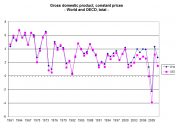The United States and New Zealand established close ties in 1942, when the U.S. provided security for New Zealand during World War II, and have remained close ever since. However, in 1984, the Labour party came into power in New Zealand, with intentions to bar nuclear-armed and nuclear-powered warships from New Zealand ports. Implementation of this anti-nuclear policy was incompatible with U.S. policy and disrupted the alliance under the Australian, New Zealand, and United States (ANZUS) security treaty of 1951. After unsuccessful attempts to remedy the issue, the United States suspended its ANZUS security obligation to New Zealand in 1986.
Despite the rupture in the ANZUS alliance, New Zealand has maintained close political, economical, and social ties with the United States. In trade, the U.S. is New Zealand second-largest supplier and customer after Australia. Trade between the two countries totaled $3.5 billion (with a $300 million surplus in the favor of the U.S.)
in 1996; U.S. merchandise exports were $1.9 billion. U.S. foreign investment in New Zealand that same year totaled $4.8 billion, and was largely concentrated in manufacturing, forestry, telecommunications services, and finance. The two countries have also worked closely together to promote free trade in the World Trade Organization and the Asia-Pacific Economic Cooperation forum.
The Labour party had not only changed nuclear policies in 1984, but also introduced a monetarist economic policy in a major effort to reduce the government budget deficit and inflation that resulted largely from an attempt in the 1970s to diversify New Zealand's production. This new plan was executed through seven major alterations: 1) The increase of privatizations through the sale of government-owned enterprises.
2) Elimination of Government subsidies.
3) Liberalization of import regulations.
4) Exchange rates freely floated.
5) Removal of controls on interest rates, wages, and prices.
6) Reduction of marginal...


